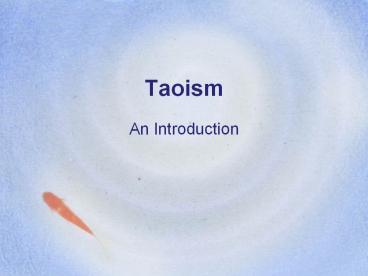Taoism - PowerPoint PPT Presentation
1 / 28
Title:
Taoism
Description:
Confucianism and Taoism. the means through which the Tao becomes manifest and actualized ... Confucianism. Vitalizing Taoisms. Increasing the 'quota' of the ... – PowerPoint PPT presentation
Number of Views:5341
Avg rating:3.0/5.0
Title: Taoism
1
Taoism
- An Introduction
2
"Certain Chinese philosophers writing in,
perhaps, the -5th and -4th centuries, explained
ideas and a way of life that have come to be
known as Taoism - the way of man's cooperation
with the course or trend of the natural world,
whose principles we discover in the flow patterns
of water, gas, and fire, which are subsequently
memorialized or sculptured in those of stone and
wood, and, later, in many forms of human art.
What they had to say is of immense importance for
our own times when in the 20th century, we are
realizing that our efforts to rule nature by
technical force and "straighten it out" may have
the most disastrous results." (From "Alan Watts
"Tao - The Watercourse Way", Pantheon Books,
1975, xiv)
3
Three Taoist Approaches
- Philosophical/School Taoism (efficient power)
- Vitalizing Taoisms (augmented power)
- Religious Taoism (vicarious power)
- This is Huston Smiths characterization.
4
- Taoism/Daoism and Confucianism are both
syncretistic philosophies that arose around the
sixth century BCE in response to the declining
power of the Zhou Dynasty (ca. 1027-256 BCE). - They find their roots in
- Ancient Chinese Religion(s)
- Buddhism
- Folk magic
- Ancestor worship
- Divination (I Ching)
5
Two ancient Chinese concepts of Ultimate Reality
Heaven (Tian, Tien), emperor as The Son of
Heaven Way (Dao, Tao) Tian?Confucianism Tao?Ta
oism
6
Transliterating Chinese Characters
British Scholars (19th cent.) developed the
Wade-Giles system. The Pinyin system was
developed in China in the 1950s and is generally
preferred.
7
(No Transcript)
8
Lao Tzu
- Lao old, venerable/ Tzu master
- Legendary history
- born with white hair
- lived to be 200 years old
- visited by Confucius
- at Hankao Pass gatekeeper insisted he write down
his teachings. - Sixth Century BCE?
9
Chuang Tzu
- ca. 370-386 BCE
- Traditional author of The Chuang Tzu
- 7 inner books
- 15 outer books
- 11 mixed books
- Identification with entire universe/not social
conformity. - Perspectivism true knowledge is perpetually
elusive - Emphasized wu-wei
- Butterfly Dreaming
10
The Three Meanings of Tao
- Tao is the way of ultimate reality.
- Tao is the way of the universe the norm, the
rhythm, the driving power in all nature, the
ordering principle behind all life. - Tao refers to the way of human life when it
meshes with the Tao of the universe. - Ultimately, Tao is ineffable.
11
Te
- Virtue
- Power
- For Taoists . . . it is the means through which
the Tao becomes manifest, actualized, and realized
12
Philosophical Taoism
- Goal(?) to align ones daily life to the Tao
- Wu Wei- pure effectiveness active inactivity
creative quietude going with the grain - A Good Traveler Leaves no Tracks (ch. 27)
- The Watercourse Way
13
Nothing in the world is softer than water, Yet
nothing is better at overcoming the hard and
strong. This is because nothing can alter
it. That the soft overcomes the hard And the
gentle overcomes the aggressive is something that
everybody knows But none can do
themselves. Therefore the sages say The one who
accepts the dirt of the state Becomes its
master. The one who accepts its
calamity Becomes the king of the world. Truth
seems contradictory. (Ch. 78, trans. Muller)
14
Other Taoist Values
- Rejection of self-assertiveness and competition
- Standing on tiptoe you are unsteady (24)
- Avoidance of aggression
- If you want to grab the world and run it/I see
that you will not succeed (29) - Naturalism, naturalness, simplicity
- Relativity
15
Though opposites, they give birth to each other.
16
(No Transcript)
17
(No Transcript)
18
(No Transcript)
19
(No Transcript)
20
(No Transcript)
21
(No Transcript)
22
Confucius and Lao Tzu
23
Confucianism and Taoism
24
Historical Varieties of Taoism
- Celestial Master Taoism (ca 150 CE, appearance of
Lao-jun, Zhang Daoling and his grandson, Zhang
Lu first form to take on institutional
trappings, priests, etc.) - Magical Taoism (Ge Hong, 4th cent. CE, alchemy)
- Supreme Clarity Taoism (365 CE, Yang Xi,
meditation, et al) - Numinous Treasure Taoism (founded by Ge Chaofu,
402 CE, incorporates Mahayana Buddhism)
25
Vitalizing Taoisms
- Increasing the quota of the Tao (chi)
breath (lit.) vital energy - eating special foods, herbsmacrobiotic diets
- acupuncture
- sexual experiments
- through bodily movements tai chi chuan
- Taoist yoga
- Feng Shui
26
Religious Taoism
- Taoism for the masses dealing with ghosts,
famines, and floods - Much in common with Chinese folk religion which
it institutionalized starting around 2nd c. CE - Seek the Tao (and thus immortality) through
liturgical and alchemical means share Taoist
concern with harmonizing the fundamental energies
in the universe
27
The Immortals and the Pantheon
- The Immortals
- Laojun (Lao Tzu, in Celestial Master Taoism)
- The Three Pure Ones Lords of Heaven, Earth, and
Humanity, symbolizing the three energies of the
human body - Jing (semen, vital essence)
- Chi (breath, vital energy)
- Shen (spiritual consciousness)
- Jade Emperor
- Dark Lord of the North
- Queen of the West
- Kwan Yin
28
Spiritual Embryo
Some Taoist practice a sort of internal alchemy
aimed at giving birth to a spiritual embryo
that will emerge as an immortal at the time of
death. This involves conserving jing (semen) to
mix with chi. (Sometimes by having sex without
orgasm, or orgasms without ejaculation.) Other
practices focus on visualization techniques
(e.g., marrying a young girl dressed in black
down from the heart to a young boy dressed in red
up from the kidneys, uniting yin and yang.)































